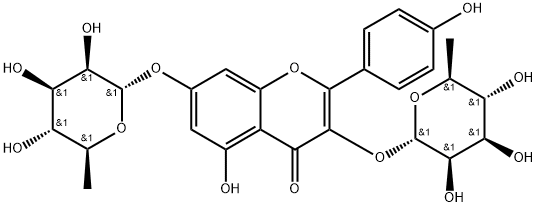Description
Kaempferitrin is a flavonoid glycoside that has been found in
B. pinnatum and has diverse biological activities. It scavenges DPPH radicals (IC
50 = 8.73 μg/ml) and is active against the bacteria
S. aureus,
P. aeruginosa, and
S. typhi, as well as the fungi
C. albicans,
C. parapsilosis, and
C. neoformans (MICs = 16-32 μg/ml). Kaempferitrin inhibits LPS-and IFN-γ-induced nitric oxide (NO) production in isolated mouse macrophages (IC
50 = 40 μM). It decreases blood glucose levels in a rat model of alloxan-induced diabetes when administered at a dose of 100 mg/kg.
Chemical Properties
Yellow crystals, soluble in organic solvents such as methanol, ethanol, DMSO, etc., derived from cockscomb, Umbelliferae plants Bupleurum, Marigold, and Kaempferia galanga.
Uses
Kaempferitirin is a glycoside of Kaempferol (K100000), a plant flavonoid that exhibits antioxidant properties and is known to reduce risks of various types cancer and cardiovascular diseases. Kaempferitirin have been isolated as natural products from plants such as Hedyotis Verticilata.
Definition
ChEBI: Kaempferol 3,7-di-O-alpha-L-rhamnoside is a glycosyloxyflavone that is kaempferol attached to alpha-L-rhamnopyranosyl residues at positions 3 and 7 respectively via glycosidic linkages. It has been isolated from the aerial parts of Vicia faba and Lotus edulis. It has a role as a bone density conservation agent, a hypoglycemic agent, an immunomodulator, an anti-inflammatory agent, an antineoplastic agent, a plant metabolite, an apoptosis inducer and an antidepressant. It is an alpha-L-rhamnoside, a monosaccharide derivative, a dihydroxyflavone, a glycosyloxyflavone and a polyphenol. It is functionally related to a kaempferol.
General Description
This substance is a primary reference substance with assigned absolute purity (considering chromatographic purity, water, residual solvents, inorganic impurities). The exact value can be found on the certificate. Produced by PhytoLab GmbH & Co. KG
Biochem/physiol Actions
Kaempferitrin (Lespenefril) is a naturally-occurring kaempferol glycoside with antimicrobial, antioxidant, and anti-inflammatory activities.
References
[1] SIMPLICE JOEL NDENDOUNG TATSIMO. Antimicrobial and antioxidant activity of kaempferol rhamnoside derivatives from Bryophyllum pinnatum.[J]. BMC Research Notes, 2012, 5: 158. DOI:
10.1186/1756-0500-5-158[2] SHIH-HUA FANG Yew M T Yerra Koteswara Rao. Inhibitory effects of flavonol glycosides from Cinnamomum osmophloeum on inflammatory mediators in LPS/IFN-γ-activated murine macrophages[J]. Bioorganic & Medicinal Chemistry, 2005, 13 7: Pages 2381-2388. DOI:
10.1016/j.bmc.2005.01.050[3] ANA PAULA JORGE . Insulinomimetic effects of kaempferitrin on glycaemia and on 14C-glucose uptake in rat soleus muscle[J]. Chemico-Biological Interactions, 2004, 149 2: Pages 89-96. DOI:
10.1016/j.cbi.2004.07.001





